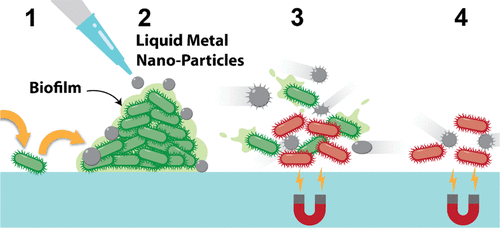Our official English website, www.x-mol.net, welcomes your feedback! (Note: you will need to create a separate account there.)
Antibacterial Liquid Metals: Biofilm Treatment via Magnetic Activation.
ACS Nano ( IF 17.1 ) Pub Date : 2020-01-10 , DOI: 10.1021/acsnano.9b07861 Aaron Elbourne 1, 2 , Samuel Cheeseman 1, 2 , Paul Atkin 3, 4 , Nghia P Truong 5 , Nitu Syed 3 , Ali Zavabeti 3 , Md Mohiuddin 3 , Dorna Esrafilzadeh 3, 6 , Daniel Cozzolino 1 , Chris F McConville 1 , Michael D Dickey 7 , Russell J Crawford 1, 2 , Kourosh Kalantar-Zadeh 8 , James Chapman 1, 2 , Torben Daeneke 3 , Vi Khanh Truong 1, 2
ACS Nano ( IF 17.1 ) Pub Date : 2020-01-10 , DOI: 10.1021/acsnano.9b07861 Aaron Elbourne 1, 2 , Samuel Cheeseman 1, 2 , Paul Atkin 3, 4 , Nghia P Truong 5 , Nitu Syed 3 , Ali Zavabeti 3 , Md Mohiuddin 3 , Dorna Esrafilzadeh 3, 6 , Daniel Cozzolino 1 , Chris F McConville 1 , Michael D Dickey 7 , Russell J Crawford 1, 2 , Kourosh Kalantar-Zadeh 8 , James Chapman 1, 2 , Torben Daeneke 3 , Vi Khanh Truong 1, 2
Affiliation

|
Antibiotic resistance has made the treatment of biofilm-related infections challenging. As such, the quest for next-generation antimicrobial technologies must focus on targeted therapies to which pathogenic bacteria cannot develop resistance. Stimuli-responsive therapies represent an alternative technological focus due to their capability of delivering targeted treatment. This study provides a proof-of-concept investigation into the use of magneto-responsive gallium-based liquid metal (LM) droplets as antibacterial materials, which can physically damage, disintegrate, and kill pathogens within a mature biofilm. Once exposed to a low-intensity rotating magnetic field, the LM droplets become physically actuated and transform their shape, developing sharp edges. When placed in contact with a bacterial biofilm, the movement of the particles resulting from the magnetic field, coupled with the presence of nanosharp edges, physically ruptures the bacterial cells and the dense biofilm matrix is broken down. The antibacterial efficacy of the magnetically activated LM particles was assessed against both Gram-positive and Gram-negative bacterial biofilms. After 90 min over 99% of both bacterial species became nonviable, and the destruction of the biofilms was observed. These results will impact the design of next-generation, LM-based biofilm treatments.
中文翻译:

抗菌液态金属:通过磁活化进行生物膜处理。
抗生素耐药性使生物膜相关感染的治疗具有挑战性。因此,对下一代抗菌技术的追求必须集中在致病细菌无法产生耐药性的靶向治疗上。刺激响应疗法由于其提供靶向治疗的能力而代表了另一种技术重点。这项研究为使用磁响应镓基液态金属(LM)液滴作为抗菌材料提供了概念验证研究,该材料可以物理损坏,分解和杀死成熟生物膜中的病原体。LM液滴一旦暴露于低强度旋转磁场,就会被物理驱动并转变其形状,形成锋利的边缘。当与细菌生物膜接触时,磁场引起的粒子运动,加上纳米锐利边缘的存在,会物理破坏细菌细胞,致密的生物膜基质被破坏。对革兰氏阳性和革兰氏阴性细菌生物膜均评估了磁活化LM颗粒的抗菌功效。90分钟后,两种细菌中超过99%不再存活,并且观察到生物膜的破坏。这些结果将影响下一代基于LM的生物膜治疗的设计。90分钟后,两种细菌中超过99%不再存活,并且观察到生物膜的破坏。这些结果将影响下一代基于LM的生物膜治疗的设计。90分钟后,两种细菌中超过99%不再存活,并且观察到生物膜的破坏。这些结果将影响下一代基于LM的生物膜治疗的设计。
更新日期:2020-01-10
中文翻译:

抗菌液态金属:通过磁活化进行生物膜处理。
抗生素耐药性使生物膜相关感染的治疗具有挑战性。因此,对下一代抗菌技术的追求必须集中在致病细菌无法产生耐药性的靶向治疗上。刺激响应疗法由于其提供靶向治疗的能力而代表了另一种技术重点。这项研究为使用磁响应镓基液态金属(LM)液滴作为抗菌材料提供了概念验证研究,该材料可以物理损坏,分解和杀死成熟生物膜中的病原体。LM液滴一旦暴露于低强度旋转磁场,就会被物理驱动并转变其形状,形成锋利的边缘。当与细菌生物膜接触时,磁场引起的粒子运动,加上纳米锐利边缘的存在,会物理破坏细菌细胞,致密的生物膜基质被破坏。对革兰氏阳性和革兰氏阴性细菌生物膜均评估了磁活化LM颗粒的抗菌功效。90分钟后,两种细菌中超过99%不再存活,并且观察到生物膜的破坏。这些结果将影响下一代基于LM的生物膜治疗的设计。90分钟后,两种细菌中超过99%不再存活,并且观察到生物膜的破坏。这些结果将影响下一代基于LM的生物膜治疗的设计。90分钟后,两种细菌中超过99%不再存活,并且观察到生物膜的破坏。这些结果将影响下一代基于LM的生物膜治疗的设计。



























 京公网安备 11010802027423号
京公网安备 11010802027423号